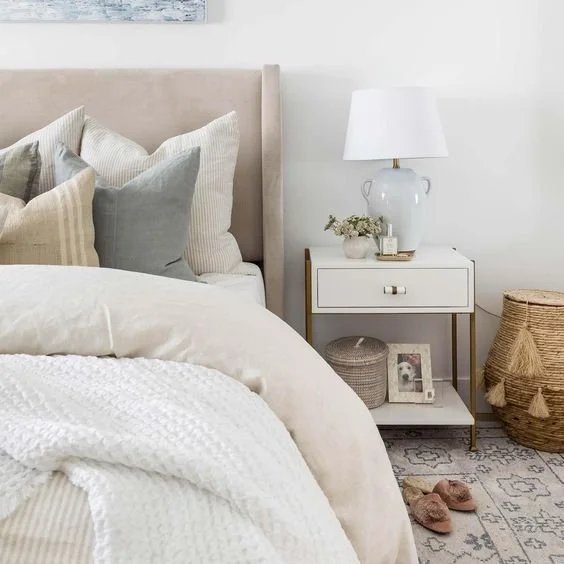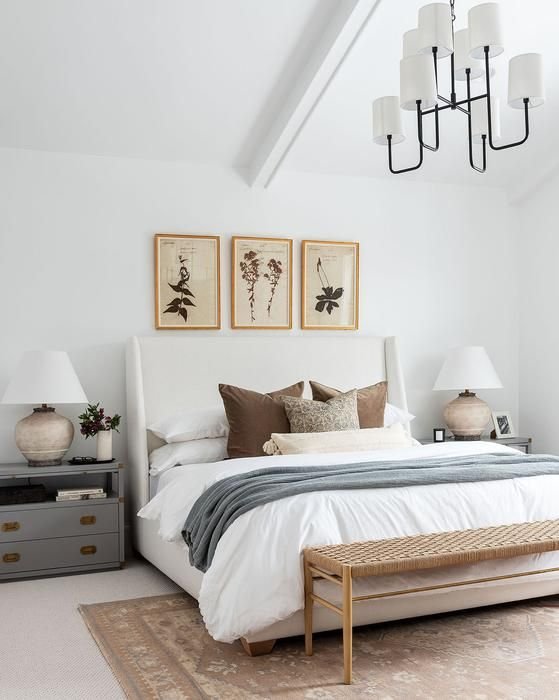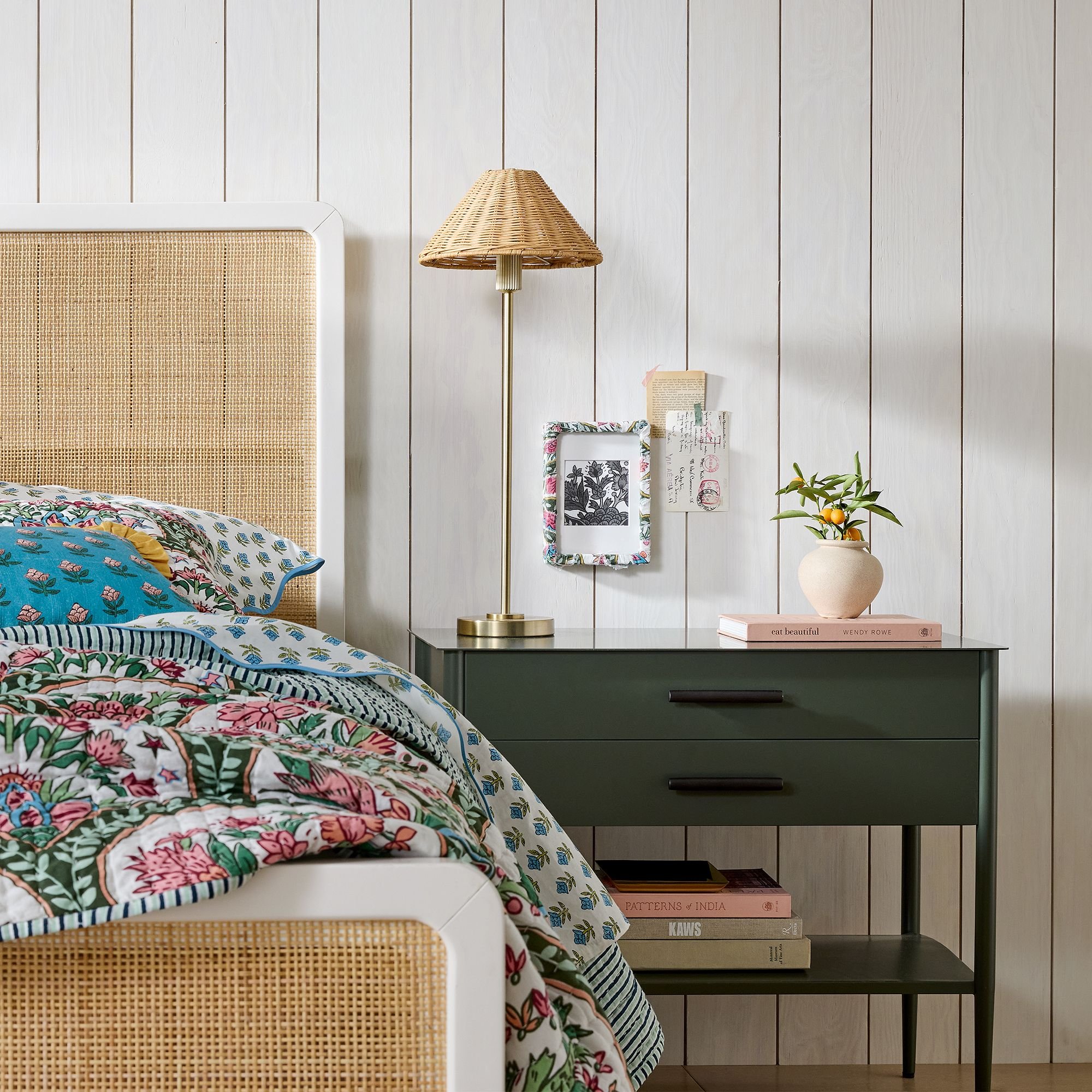The Ultimate Guide For Choosing the Right Nightstands
via Eclectic Modern Guest Room Reveal
Nightstands are more than just pieces of furniture next to your bed; they should be both a functional and stylish addition to your bedroom! Whether you're an avid reader who needs a spot for your books or someone who values the convenience of having essential items within arm's reach, choosing the right nightstand is crucial. In this design guide, we'll explore key considerations (and look at some beautiful inspiration along the way) to help you make an good choice so you can make your selections with confidence!
There’s a lot of flexibility in design - that’s what makes every room unique and special! So I like to think of the guidelines I’m sharing today as just that - guidelines. Depending on your specific space, you may need to “break the rules” and that’s ok . Do what works best.
You’ll also hear some of my own personal preferences reflected in these thoughts (I do have opinions, ha!). My years as a designer have taught me a lot about what works, what’s practical and what just looks good together.
Let’s dive in!
Nightstand Size and Scale
Before you start your search, measure the available space beside for nightstands and the bed itself. The nightstand's size should complement the dimensions of your bedroom and the bed itself.
Ideally, the nightstand should be about the same height as the top of your mattress or a little higher (2-4”), making it easy to reach items from bed without straining.
Width matters as well. You want your nightstand to be proportional to your bed, but there’s a good amount of wiggle room here. In general, the wider the bed, the wider you want your nightstand to be. What you don’t want is a dinky side table next to a king bed - it won’t look right!
Width guidelines:
Twin bed: 17-20” wide (exception: if you have two twin beds in a room with a nightstand between, you’ll want it to be wider - ideally spanning the walkway between the beds)
Queen bed: 20-26” wide
King bed: 24”+ wide
Style and Aesthetics
Consider the overall style of your bedroom when choosing a nightstand. The nightstand should complement the other pieces in the room like your bed, dresser, and other furniture pieces.
Note the word complement, not match. You want to look for pieces that balance each other out and/or flow nicely together. For example, if you have an upholstered bed, a nightstand in a natural wood makes for a great complement. Or if you have a wood bed, consider nightstands in a metal or painted finish that works with the other finishes in the room.
via Farrow & Ball
Storage Needs
Think about your storage needs before settling on a nightstand. What do you normally keep on your nightstand? What do you like to stash away? Do you need room for a lot of items or do you keep it simple?
If you like to keep several books on hand for example, look for a nightstand with an bottom shelf that’ll keep those neat and tidy. If you like to have a clutter-free surface, you may want several drawers for organization.
via Pure Salt Shoppe
Material and Durability
Nightstands come in a variety of materials, including wood, metal, glass, and even acrylic. Choose a material that not only complements your bedroom's style but also meets your durability expectations. Solid wood nightstands are a classic choice known for their longevity, while metal and glass can offer a more contemporary vibe.
via McGee & Co.*
Balance and Symmetry
Do your nightstands need to match? That’s a pretty common question I get, and the answer is no, but they usually do. A matching set offers really nice balance and symmetry, but if your style is a bit more eclectic or you need different pieces on each side for practical reasons, it’s ok if they don’t match.
My default is to choose matching nightstands unless circumstances call for it. One great example of this is if the bedroom needs to serve multiple purposes like as an office in addition to a guest room. There may not be room for a desk on a separate wall, so we may opt to make one of the nightstands a desk!
If you do choose different ones for each side, be sure their height is within an inch or two if you’re going to be using table lamps on them so that the overall height is the same. If the heights of your tables are significantly different, consider using wall sconces instead - you can mount them at the same height to create balance to compensate for the difference in nightstand height.
Want to dig deeper into the idea of mismatched nightstands? I wrote a post about just that - find it here!
via West Elm
To wrap things up…
Choosing the right nightstand for your bed is a dance - you’re blending functionality, style, and personal preferences. By striking the right balance, you can find a nightstand that complements your bedroom's aesthetics while enhancing its practicality. Remember, the nightstand is more than just a place to rest your items; it's an integral part of creating a comfortable and inviting bedroom retreat!
Looking for some sure-fire beds and nightstand combos? If you’re on the hunt, check out the followup post to this one by tapping the button below!
*This post contains affiliate links, which means Mix & Match Design Co. earns a small commission from your purchase at no cost to you.






